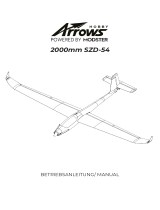
!"#!
Vector Flugsteuerungssystem Handbuch
Vector Flugsteuerungssystem Übersicht
1. Das Arrows Hobby Vector Flugsteuerungssystem ist ein digitaler Co-Pilot, der speziell für Ihr
Flugzeug programmiert wurde.
2. Für Anfänger bietet der Vector einen sicheren Flugbereich, um den Piloten beim Erlernen des
Fliegens zu unterstützen.
3. Für fortgeschrittene und bereits erfahrene Piloten kann der Vector die Auswirkungen von
Windbögen mildern, während er dem Piloten erlaubt, die vollständige Kontrolle zu behalten und
komplexe Manöver durchzuführen.
Das Vector Flugsteuerungssystem arbeitet in 3 Flugmodi - Stabilität, Dynamik und Direktflug; der Übergang zwischen den 3 Flugmodi erfolgt über
einen 3-Positionen-Schalter am Sender - die mittlere Position ist standardmäßig der Direktflugmodus.
Hinweis: Wenn nur ein Schalter mit 2 Positionen vorhanden ist, schaltet das Vector System nur zwischen den Flugmodi Stabilität und Dynamik um.
Stabilitäts Modus - Der Vector bringt das Flugzeug in den Horizontalflug zurück, wenn keine Steuereingaben erkannt werden. Perfekt für Piloten-
anfänger oder als sicherer Modus in Notsituationen.
Dynamischer Modus - In diesem Modus behält der Pilot die vollständige Kontrolle über das Fluggerät. Der Vector-Flugregler nimmt nur dann
Steuereingaben vor, wenn er eine Bewegung erkennt, die nicht vom Piloten initiiert wurde (Windböen, Seitenwind, usw...)
Direkt Modus - Für erfahrene Piloten, die ein reines Flugerlebnis ohne elektronische Eingriffe erleben wollen, werden zu keiner Zeit Eingaben vom
Flugregler gemacht. Es sei denn, er wird zurück in den Stabilitäts- oder Dynamik-Modus geschaltet.
1. Stellen Sie das Flugzeug auf eine ebene Fläche, schalten Sie den Sender und dann das Flugzeug ein.
2. Warten Sie, bis sich die Vector Flugsteuerung selbst kalibriert hat (Status-LED blinkt schnell).
3. Wenn der Kalibrierungs-Prozess abgeschlossen ist (nach ca. 3 Sekunden), schaltet das Flugzeug die Querruder- und Höhenruder-Servos
jeweils dreimal ein - dies zeigt einen erfolgreichen Kalibrierungs-Prozess an.
4. Flugmodus-Status-LED: Schnelles Blinken = Stabilisiert, kurzes Blinken= Direkt, Ein= Dynamisch.
Hinweis: Prüfen Sie vor dem Flug immer, ob die Steuerflächen in der richtigen Richtung reagieren. Umgekehrte Steuerflächenbewegungen können
dazu führen, dass das Flugzeug unkontrollierbar wird.
1. Sbus- und PPM: Schließen Sie das Sbus/PPM-Kabel direkt an den Sbus-Anschluss des Empfängers an. Achten Sie dabei genau auf die Polarität
des Kabels. Beachten Sie, dass die Kanalreihenfolge lautet: Querruder, Höhenruder, Gas und Seitenruder.
Verwenden Sie den Sender, um die Reihenfolge zu korrigieren, wenn die Standardeinstellungen nicht mit der Reihenfolge übereinstimmen.
Sbus / PPM /PWM EINGABE
Sbus / PPM /PWM EINGABE
1. PWM-Empfänger: Schließen Sie das Sbus/PPM-Kabel an einen freien Kanal an, der einem 2- oder 3-Stellungsschalter zugeordnet werden
kann. Schließen Sie an alle anderen Kanäle entsprechend der Beschriftung auf dem Servokabel an.
Funktionsweise
Initialisierung bei der Kalibrierung
Sbus- und PPM Empfänger
HÖHENRUDER KANAL
HÖHENRUDER KANAL
HÖHENRUDER KANAL


